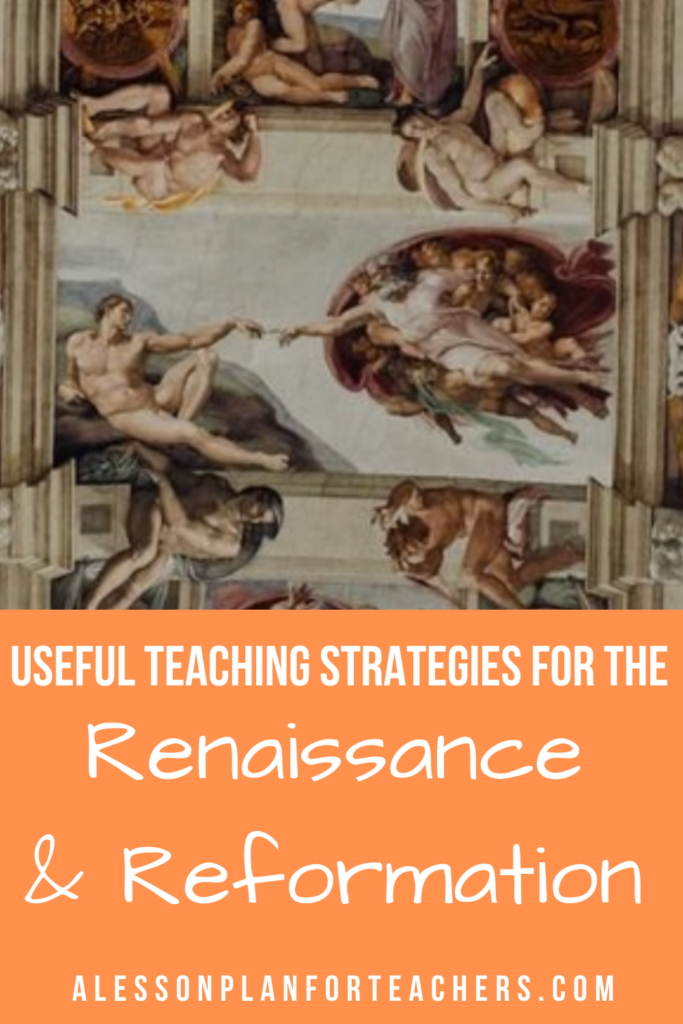The Renaissance and Reformation unit is often the transition from the Middle Ages into modern times in World History. As such, many courses across the country start with this unit. Engaging students here with useful and effective teaching strategies helps set the foundation for future learning. This unit is awesome for introducing those engaging lessons!

This unit is ripe with student learning skills like image analysis, cause and effect, and mapping. Studying these skills early in the year will better prepare students to tackle difficult content areas down the road. Reinforcing these skills is vital for student comprehension and retention.
Skills to Introduce the Renaissance and Reformation Unit
Social Studies skills must be practiced in every course. In the Renaissance and Reformation unit, it’s much easier to address and teach these skills than it will be in units further ahead in the course.
- Reading for Content – This unit is filled with content important for students to understand prior to continuing the course.
- Primary Source Analysis – With so much available from this period in history, including primary sources is a must!
- Image Analysis – This is the Renaissance we are talking about!
- Historical Thinking – This time period lends itself for deeper historic thought.
- Cause and Effect – With a clear transition from the Middle Ages, this unit helps reinforce this skill.
- Mapping – Changes in this era are perfect for practicing geographic skills.
- Comparison & Change Over Time – Transitional units address these skills and help to define them for students.
You’ll find that many of these skills overlap from other courses. However, mapping in a History course should take on new meaning compared to basic geography courses students have had in the past. Integrating mapping in History will help bridge the gap between skills and content retention.
Useful Teaching Strategies for this Unit
Other units can be more challenging in utilizing interactive and creative strategies. However, the Renaissance and Reformation unit is a perfect fit! The content focuses on innovation and artistic endeavors opens doors for engaging strategies.
- Art Analysis – The Renaissance is art! Allowing students to take in the art of this period and analyze it for significance can open so many doors into the content and historical importance of the period.
- Meet & Greet Activities – Introducing many different characters from this period in history can be done easily with activities where students take on the roles of those historic figures.
- Historical Mapping – Creating maps where students trace the events of the period help them to not only see locations but also trends and movement through time.
- Step-Notes Lectures – With so much cause and effect apparent in this unit, especially when teaching the Reformation as a response to the Renaissance, Step-Notes can help students visualize the changes.
- Walking Tours/Museum & Art Gallery Walks – This unit is full of great content! To cover all of that content in a reasonable amount of time, you need strategies like Walking Tours and Gallery Walks that help students collect, categorize, and process information quickly and effectively.
- Jigsaw Activities – Letting students process information to share with others is a quick and easy way to help cover and compare like and different topics. In teaching the Reformation, this strategy is especially helpful.
Fun & Engaging Resources to Teach the Renaissance and Reformation
The full Renaissance and Reformation Unit has everything you need! From unit plans with daily bellringers and exit prompts to engaging lessons, it’s all included. This unit uses the above strategies at length and keeps students excited about learning.
The Renaissance Virtual Art Tour takes students into the past to visit the masters and their works. At the same time, students practice image analysis to make historical connections.
Transport students to another time with the People of the Renaissance Meet & Greet Activity. This activity gets students out of their chairs and collaborating to learn about the people of the era.
Lastly, the Reformation Three Branches Jigsaw Activity has students working together to examine the breaks in Protestantism. Students learn to compare while looking at the root causes of each break.

By showcasing these skills and strategies in your classroom, students will engage with the lessons. The Renaissance and Reformation Unit will leave your class with a deep understanding of the content. These exciting and collaborative exercises are sure to get students moving and thinking!
Happy Teaching!
